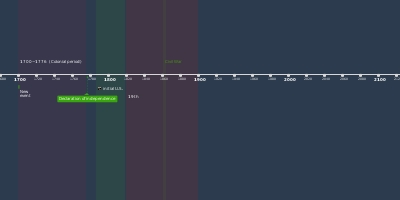Great Depression (1 Jan 1929 Jahr – 1 Jan 1941 Jahr)
Beschreibung:
Following the stock market crash, the worldwide economy plunged into the Great Depression. The U.S. money supply began to contract by one-third. The protectionist Smoot–Hawley Tariff Act incited retaliation by Canada, Britain, Germany and other trading partners. Congress, in 1932, worried about the rapidly growing deficit and national debt, and raised income tax rates. Economists generally agree that these measures deepened an already serious crisis. By 1932, the unemployment rate was 25%. Conditions were worse in heavy industry, lumbering, export agriculture (cotton, wheat, tobacco), and mining. Conditions were not quite as bad in white collar sectors and in light manufacturing.- Franklin D Roosevelt was elected President in 1932 without a specific program. He relied on a highly eclectic group of advisors who patched together many programs, known as the New Deal.
- Spending -
Government spending increased from 8.0% of GNP under Hoover in 1932 to 10.2% of GNP in 1936. Roosevelt balanced the "regular" budget the emergency budget was funded by debt, which increased from 33.6% of GNP in 1932 to 40.9% in 1936.
- Deficit spending had been recommended by some economists, most notably John Maynard Keynes in Britain. Roosevelt met Keynes but did not pay attention to his recommendations. After a meeting with Keynes, who kept drawing diagrams, Roosevelt remarked that "He must be a mathematician rather than a political economist".
- John Keynes's approach to the great depression could have been a solution. His method was to keep the feds spending as much as they could even on random purchases but the money had to keep moving. It is believed that if America went through with John Keynes plan the Great Depression could have been avoided entirely. The Feds started to spend more when President Roosevelt came in to office as the federal government doubled income tax rates in 1932.
- Total government tax revenues as a percentage of GDP shot up from 10.8% in 1929 to 16.6% in 1933. Higher tax rates tended to reduce consumption and aggregate demand. Spending would go up and America would get out of the great depression when World War II happened after Japan’s attack on American forces in Pearl Harbor in December of 1941 led to much sharper increases in government purchases, and the economy pushed quickly into an inflationary gap.
Banking crisis
In 1929–33 the economy was destabilized by bank failures. The initial reasons were substantial losses in investment banking, followed by bank runs. Bank runs occurred when a large number of customers lost confidence in their deposits (which were not insured) and rushed to withdraw their deposits. Runs destabilized many banks to the point where they faced bankruptcy. Between 1929 and 1933 40% of all banks (9,490 out of 23,697 banks) went bankrupt. Much of the Great Depression's economic damage was caused directly by bank runs.
- Hoover had already considered a bank holiday to prevent further bank runs but rejected the idea because he was afraid to trip a panic. Roosevelt acted as soon as he took office; he closed all the banks in the country and kept them all closed until he could pass new legislation.
- On March 9, Roosevelt sent to Congress the Emergency Banking Act, drafted in large part by Hoover's top advisors. The act was passed and signed into law the same day. It provided for a system of reopening sound banks under Treasury supervision, with federal loans available if needed. Three-quarters of the banks in the Federal Reserve System reopened within the next three days. Billions of dollars in hoarded currency and gold flowed back into them within a month, thus stabilizing the banking system.
- By the end of 1933, 4,004 small local banks were permanently closed and merged into larger banks. Their deposits totaled $3.6 billion; depositors lost a total of $540 million, and eventually received on average 85 cents on the dollar of their deposits; it is a common myth that they received nothing back. The Glass–Steagall Act limited commercial bank securities activities and affiliations between commercial banks and securities firms to regulate speculations. It also established the Federal Deposit Insurance Corporation (FDIC), which insured deposits for up to $250,000, ended the risk of runs on banks.
Unemployment
Unemployment reached 25 percent in the worst days of 1932–33, but it was unevenly distributed. Job losses were less severe among women than men, among workers in nondurable industries (such as food and clothing), in services and sales, and in government jobs. The least skilled inner city men had much higher unemployment rates, as did young people who had a hard time getting their first job, and men over the age of 45 who if they lost their job would seldom find another one because employers had their choice of younger men. Millions were hired in the Great Depression, but men with weaker credentials were never hired, and fell into a long-term unemployment trap. The migration that brought millions of farmers and townspeople to the bigger cities in the 1920s suddenly reversed itself, as unemployment made the cities unattractive, and the network of kinfolk and more ample food supplies made it wise for many to go back.
City governments in 1930–31 tried to meet the depression by expanding public works projects, as president Herbert Hoover strongly encouraged. However tax revenues were plunging, and the cities as well as private relief agencies were totally overwhelmed by 1931 men were unable to provide significant additional relief. They fell back on the cheapest possible relief, soup kitchens which provided free meals for anyone who showed up.[302] After 1933 new sales taxes and infusions of federal money helped relieve the fiscal distress of the cities, but the budgets did not fully recover until 1941.
Zugefügt zum Band der Zeit:
Datum:
1 Jan 1929 Jahr
1 Jan 1941 Jahr
~ 12 years
